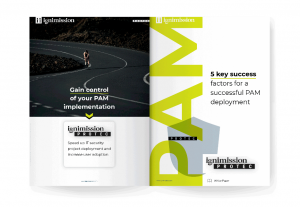First key factor for a successful PAM project: Change Management
Last week we launched our very first white paper on how to have a successful PAM deployment. We have identified 5 key success factors to consider in the early stages of your project to ensure its success and the first step is all about Change Management.

What is Change Management?
One popular definition by Moran & Brightman in 2001 says that it is, “the process of continually renewing an organization’s direction, structure, and capabilities to serve the ever-changing needs of external and internal customers.”
Notice that the two general sides here, the “organization’s direction, structure, and capabilities” and “external and internal customer”, are both continually changing.
That is to say, in our context, that our IT systems and organizational needs will not be the same when we finish the implementation as when we started it, and that the people who are impacted will not be the same or feel the same, either. Therefore, none of this is going to be easy.
Here, we are most concerned with the “internal customers,” who are primarily employees but could also be contractors, consultants, and partners. These are the people who might have strong opinions about PAM or even just a particular aspect of the implementation project. They might feel threatened by the potential loss of responsibility or power or even their position, and they might consider what options they have at hand to challenge or derail the project.
The first step is to make sure important stakeholders feel like they can have some input into the process. For example, have one-on-one meetings with key people before any larger meetings. Identify any issues they have, and address them up-front. This will allow to identify any possible problem, to deal with it in advance and to give the vision on the issues and good practices to the key parties.
PAM involves a change in the way of doing things, and very often, people simply don’t like change. If you are lucky, you have the strong support of the organization behind you — make it clear when you are introducing your plan that it is a foregone conclusion. If your organizational support is not as strong as you would like it to be, you might have to be prepared to negotiate.
Taking the time to understand needs, make allies, and conduct negotiations will increase the likelihood that you will be able to look back at the project as a success.
To read about the rest of our steps to obtain a successful PAM deployment project download our white paper here: https://ignimission.ac-page.com/en-ignimission-protec-white-paper



